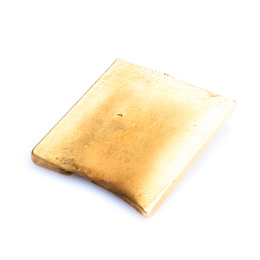What is Rose Gold?
Whilst gold and silver may have been used to make jewellery for generations, it seems that rose gold has suddenly exploded onto the scene. It is everywhere nowadays, from body decoration to homeware to jewellery. However, rose gold and its gorgeous, deep colours, have actually also been in use for hundreds of years due to its attractive properties.
With its romantic, pinkish hues, rose gold has grown in popularity over the years for use in engagement rings, necklaces , bracelets , and is now considered one of the most popular colours.
But what actually is rose gold? Is it real gold? And why is it used in jewellery?
A brief history of rose gold
Rose gold was first used in Imperial Russia in the 19th century, when renowned jeweler Carl Fabergé began using it in his famous Fabergé eggs, made special for the Russian royal family. It was known then as Russian gold. Its popularity eventually spread abroad and Victorian jewelers in England began using rose gold in the late 1800s and early 1900s.
Throughout the golden years of the 1920s rose gold was enormously popular in the United States and elsewhere in jewellery.
As gold has traditionally been used as a symbol of importance and wealth, rose gold also became a sign of wealth and status.
Famed designer Cartier was especially instrumental in the rise of rose gold, with their famous ‘Trinity Ring’, and its popularity lasted until the financial crisis of the early 1930's. Platinum then became the metal of choice for jewellery, due to its bright, white colours.
However, as World War II unfolded, platinum was used more prominently in the war effort and became rarer and more expensive. Jewelers once again returned to using rose gold for pieces, and the popularity of this colourful metal had returned by the late 1940s and 1950s.
Is rose gold real gold?
Rose gold is real gold, but it is a mix, or alloy, made up of copper and yellow gold blended together. Yellow gold needs to be blended, or alloyed, together with other metals to make it stronger in jewellery, as yellow gold in its natural state is a soft, malleable metal. The addition of other metals allows rose gold jewellery to last longer, and tarnish less than other metals.
24 karat gold is pure 100%, yellow gold. The less yellow gold used means the karat number drops. An 18 karat piece, for example, is 75% yellow gold, with the remaining 25% made up of another metal to give the jewellery a distinctive colour.
The higher the yellow gold content in a piece of jewellery, the more gold- coloured it will appear. The higher the content of other metals, the more the colouring changes.
So what actually makes rose gold?
Rose gold, along with pink and red gold, is made with an alloy of yellow gold, copper, and sometimes silver is added. The higher the copper content, the stronger the reddish hue will appear.
Pink gold, for example, uses the least copper. 18 karat pink gold will be 75% gold, 20% copper and 5% silver.
Rose gold has a stronger copper content. 18 karat rose gold will be 75% gold, 22.25% copper and only 2.75% silver.
Red gold is the strongest of the reddish hues. 18 karat red gold contains 74% gold and 25% copper.
Is rose gold more expensive than yellow gold?
The use of copper in rose gold does not necessarily make it more or less expensive than yellow gold. Since 14 karat or 18 karat rose gold pieces contain the same amount of gold as 14 karat or 18 karat yellow gold, they essentially have the same value.
The same is true for white gold aswell. The number of karats determines the percentage of pure yellow gold so a 14 karat or 18 karat white gold piece intrinsically has the same value as a yellow or rose gold piece. How can you tell if rose gold is real?
How can you tell if rose gold is real? If you know the karat of your piece of jewellery, it is possible to determine how real or fake it may be. Because rose gold is an alloy of different metals, pure rose gold does not exist. Therefore, if your jewellery is labeled as 24 karat rose gold, it is more than likely fake.
Does rose gold tarnish?
Tarnish refers to jewellery losing its luster, and when the colouring starts to fade as a result of exposure to air or moisture.
Gold in its purest state, 24 karats, does not combine easily with oxygen and therefore does not tarnish much. However, as gold is alloyed with different metals, they do react with oxygen and tarnishing occurs.
Due to the higher copper content in rose gold compared to yellow gold, it doesn't tarnish as a normal gold piece would. Instead, over time it gains patina. But what is patina? Patina is thin layer that forms on the surface of copper and other materials that gives it an older, more vintage look. A good example of this would be the Statue of Liberty. Originally copper coloured, over time patina has turned one of the world's most famous landmarks into its now-classic green hue look.
Some people love, and even strive for, that vintage style, and the colouring of rose gold can make older jewellery look classic. But patina is easy to clean off if you wish, keeping your rose gold clean and fresh for as long as you want.





















